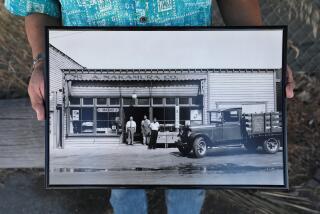In Japan, a town on verge of falling off the map
- Share via
KANNA, JAPAN — Shop owner Hideo Sakamoto knows this sad truth about his dying town: When he retires, no one will be left to take the reins of his tiny business selling eyeglasses and clocks.
His two children have fled to big cities and his mother is bedridden. “It’s a sad story,” says the 57-year-old, “because I will not be passing down my business to my children.”
And not just that, he says. He and his wife, Mariko, are “so lonely.”
Almost every day, this Japanese town surrounded by streams and mountains is eerily quiet, with only a few elderly people walking down its narrow streets.
Once a busy lumber and agricultural center, Kanna has seen its leading businesses close and its population plummet from 20,000 in the late 1970s to 2,600 today.
More than 60% of its residents are older than 65. Only about 80 children attend the two elementary and two junior high schools. For high school, most youngsters are sent to larger communities, and don’t come back to live here.
Six years ago, the towns of Manba and Nakasato merged to form Kanna in an effort to save the traditions and rich cultural heritage of the area. The town is about three hours northwest of Tokyo, and one of 62,000 government-designated dying villages.
In the last decade, about 200 communities in Japan have indeed vanished. And on Hokkaido, Japan’s northernmost large island, almost 10% of the towns are endangered, with half of those expected to disappear in the next 10 years.
With few jobs or social opportunities, towns like Kanna have little to offer the younger generation. Meanwhile, throughout Japan, women are marrying at a later age and fewer are choosing to have children. If the current fertility rate of 1.3 children per woman continues, the International Organization for Migration says, Japan’s population will fall to 100 million from more than 125 million by 2050.
Japan now has one of the world’s biggest populations of people older than 65 -- 22%, compared with 13% younger than 15. More than two in five people living in rural villages are older than 65, and older people make up more than half the populations of about 8,000 towns and villages.
In Kanna, the older adults are left to take care of the very old. For example, Kiyoshi Arai, 66, who along with his wife owns one of the few remaining restaurants in the village, watches over his 88-year-old mother, Kaoru.
And, he says, “my daughter has already left and doesn’t want to come back.”
The only jobs now are in schools, the town hall or public services, says former Mayor Motoo Kuroda, 78.
“We used to have a successful lumber and farming industry, and our children followed what we did,” Kuroda says. “But the price of lumber dropped when timber became available from overseas. The huge farming enterprises undersell us.”
The town, he says, has changed a great deal. “There used to be so many people here. They would come for the lumber. But today the government for environmental reasons protects the forest. But even if we did cut the trees down, we couldn’t make enough profit.”
There are no clubs, cinemas, cafes or video shops to entice young people to stay, Kuroda says.
His four children have left. His eldest son, who just retired at 60, promised to come back and take care of him and his wife when they need him to.
“But we don’t wish to give him any trouble,” Kuroda says.
The elderly, who are holding the town together, spend their days playing gate ball, a Japanese form of croquet, and participating in the few other community activities.
Residents say the national government isn’t doing enough to prevent Kanna from disappearing. The government gives towns low-interest loans to maintain the infrastructure, but that’s it.
Kanna’s 69-year-old mayor, Tetsujuro Miyamae, believes there’s still hope for the town.
In a scheme to attract more tourists, Kanna is expanding its dinosaur museum. Opened a decade ago, it holds bones from Utah and Mongolia, as well as a newly purchased Tyrannosaurus rex skeleton from Montana. At the museum’s theater, children and their parents watch man-made dinosaurs roar across the stage.
Visitors can also hike up the mountain behind the museum and dig for fossils, though none have been found in Kanna. More than 50 footprints believed to be of dinosaurs have been discovered over the years, however.
The town is also hoping to attract manufacturers.
On Hokkaido, one town tried, with little success, giving away plots of land to people who agreed to move there and register as official residents. Another Hokkaido town was pressed this year to advertise several of its schools on Yahoo’s auction site owing to the drastic decline in enrollment. One school was converted into a nursing home for the elderly.
Kanna hopes to avoid such a fate, and some residents say they’ll stay put. Yushi Kanbara, in his 20s, was born nearby and works at the town hall.
“I love it here,” he says. “The nature, the clean air and the fishing.”
More to Read
Sign up for Essential California
The most important California stories and recommendations in your inbox every morning.
You may occasionally receive promotional content from the Los Angeles Times.










